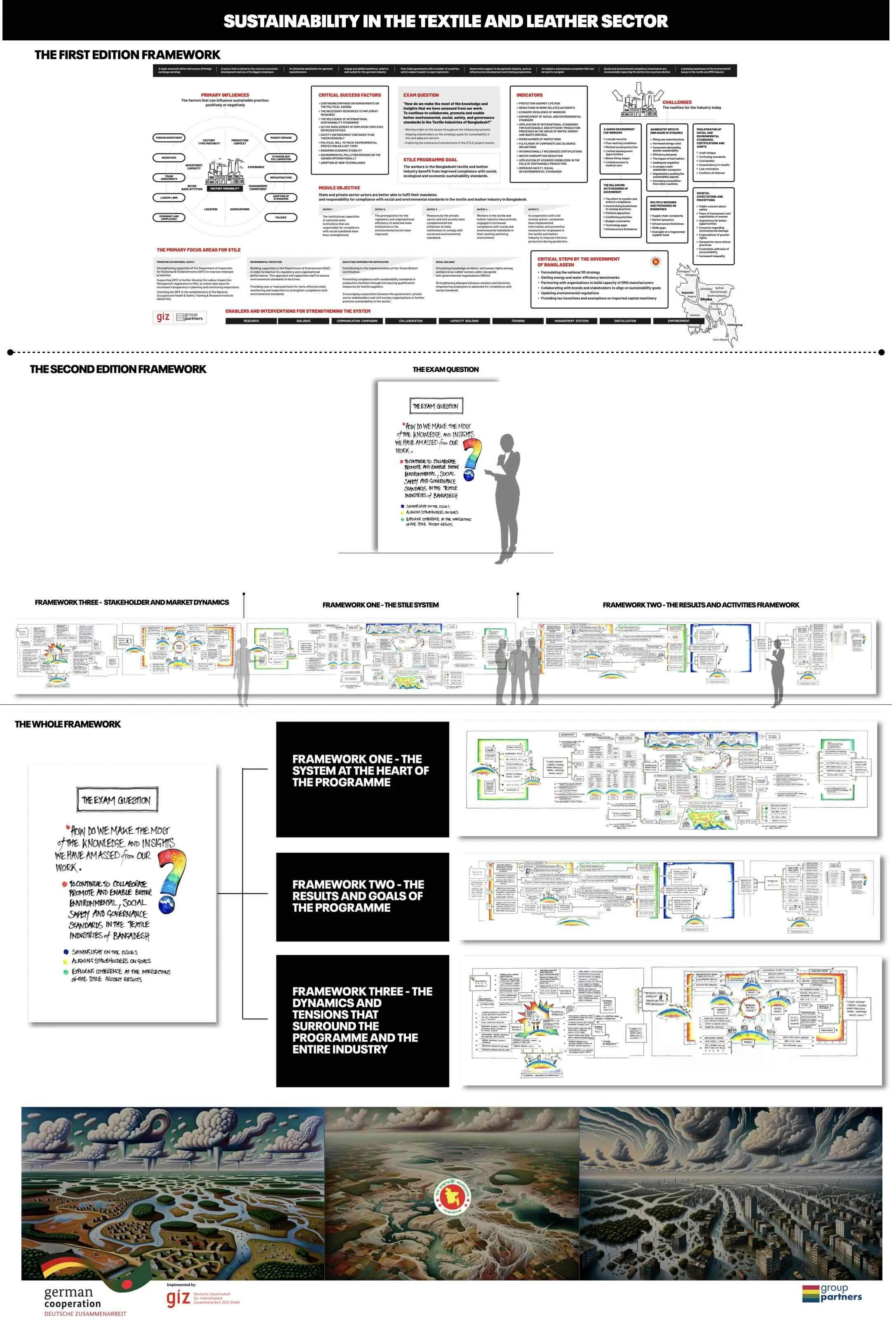
The STILE Sessions
High-Level Summary
From the 1st to the 5th of October 2023, stakeholders convened at the Radisson Water Garden, Dhaka, Bangladesh, for a sequence of STILE Sessions.
This document serves as a comprehensive reference and reflection of the discussions. It details the program's systematic approach towards fostering a sustainable and resilient textile industry in Bangladesh.
NB: This document is designed to be viewed on a laptop or desktop.
We delved deep into the industry's intricacies through three frameworks, understanding it as a complex interwoven set of systems.
These frameworks captured everything from the buyer's journey and the role of government to the tensions and dynamics inherent in the textile industry's stakeholder landscape.
A central 'exam question' guided our discussions:
"How do we harness our collective knowledge and insights to further sustainability standards in Bangladesh's textile sector?"
We present the essence of our discussions through images, videos, and more detailed narratives, hoping they serve as a model for future endeavours in this industry.
Sustainability - A Working Definition and Our Context
In the context of the textile industry in Bangladesh—or any textile industry for that matter—sustainability can be defined as:
"The practice of creating, manufacturing, and distributing textiles in an economically viable, socially responsible, and environmentally benign manner, both for the present and future generations."
At the very least, this means:
Economically Viable: The industry must be profitable to sustain itself. However, long-term economic viability also involves investing in workers through fair wages and safe working conditions and investing in technologies and practices that may have a higher upfront cost but lead to long-term savings and resilience.
Socially Responsible: This encompasses fair labour practices, ethical treatment of workers, and creating a work environment that is not just safe but also conducive to the well-being and development of the workforce. Social responsibility extends to the communities where these factories operate, ensuring that the industry contributes positively to the local society.
Environmentally Benign: This involves minimizing waste, reducing energy consumption, and using sustainable materials. It also means responsible disposal of waste and emissions and, ideally, moving towards a circular economy where waste is minimized and materials are recycled or upcycled.
In essence, sustainability in this context is a multi-dimensional approach beyond mere compliance with laws and regulations. It's about creating a new standard for how a responsible textile industry should operate.
As the economist E. F. Schumacher once said, "Any intelligent fool can make things bigger, more complex, and more violent. It takes a touch of genius—and a lot of courage—to move in the opposite direction." The textile industry has a unique opportunity to prove that sustainability and profitability aren't mutually exclusive but are, in fact, complementary.
Frameworks and Their Details:
The System Framework: This involves understanding the buyer's journey, the factory lifecycle, the role of government, and essential contributions and mechanisms for creating and sustaining a socially just, environmentally responsible, economically viable industry.
Mapping The Impact: This framework focuses on the STILE program’s focus and objectives, along with the expected outcomes and results.
The Stakeholder Factors: This deals with stakeholders' inherent tensions and dynamics. It shows stakeholders' unique needs and motivations and where conflicting motivations can create tension.
The Dynamics: This section elaborates on the (primarily external) factors that impact the textile industry, both positively and negatively. Factors that we may or may not be able to control.
STILE Activities: This is the focus for the STILE program. They shed light on the various initiatives and activities contributing to the program's progress and impacting those outcomes and results.
Appendices: This section provides a current snapshot of some of the identified strengths and weaknesses across the textile system in Bangladesh from the STILE program perspective, highlighting both positive progress and areas that need more attention.
Here, you can download the images, see video guides and read concise narrative descriptions of each section; there is a full explanation of the frameworks we worked on together during the week.
You can ask our AI for detailed information and explanations about the process and the definitions we use in our work.
A Context
We positioned the ‘system’ at the heart of everything in the framework to contextualise all the aspects of the STILE program in its pursuit of goals for this industry.
This document covers the program's contribution to governance and the compliance requirements of a more sustainable textile industry in Bangladesh while recognising how all key stakeholders play a part through their various systems, processes, regulations and roles.
There is no single system.
Every complex environment consists of multiple subsystems that together create what we know and experience in the industry of interest.
Representing work through understanding purpose, values, contribution, operation and accountability across these systems is crucial and effective for building knowledge and understanding at the right level. We made the point during the week that this is just one way of explaining the system. As with any living system, no hierarchy is sugested.
Everything is essential for a system to work to everyone’s benefit.
This work is the culmination of several stages of work with the GIZ team. These stages included access and assimilation of existing information and independent information gathering—the research, analysis, synthesis and structuring of this information developed by the STILE team and many stakeholders.
This analysis was then configured into frameworks that would stimulate further discussion during the week and do justice to the substantial work already conducted by all the stakeholders on certain system elements.
These frameworks are explained in detail in the next section.







